There is something fresh and undefinable in the art practice of KT Duffy that clearly resonates deeply with my current interests. This youthful artist is producing musing works from a standpoint that is unlike anything I have encountered previously. The visionary approach and willingness to explore new ideas and materials is that phenomenon that immediately drew me in. This week the COMP Magazine visited Duffy in (their) west Fulton Street studio to discuss growing up on the southwest side of Chicago near Midway Airport, the way in which gender and identity unfold in (their) investigations, the fascination with new technology and how that impacts the viewing experience, and the how the shifting aesthetic landscape is being shocked through evolving cultural and technological transformation.
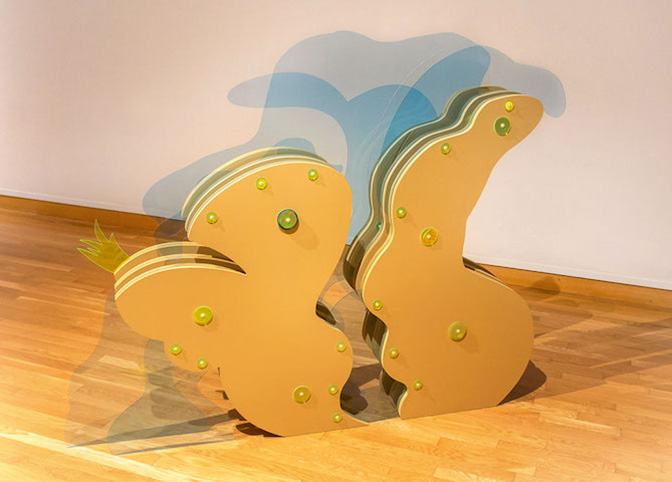
KT Duffy, Call Me Mother, acrylic, plywood, PLA, vinyl, 48” x 50” x 13”, 2018
Initially, one of the items that drew me to the work is how you reference yourself as creator of your artworks. There’s a plurality in the voice. I see you referencing yourself in the 3rd person, frequently as ‘their’, also I see an identification of the convergence/divergence of the digital and physical self. Am I correct in noting this? Can you expand upon these observations?
I initially started using the 3rd person in my artist and research statements because I hated the way all the I- I-I’s, me-my-me’s, read. So now, when I write about the (my) self in my work the “their/they” serves two purposes. First, it asserts my identity as a gender non conforming type of human/lumpy sentient thing. They/their are singular pronouns. However, because their/they can also be plural, it became an opportunity for me to play with this plurality and ideas of ownership in my practice.
That most of my parts and pieces are created in the computer, and then sent to a device to fabricate, it definitely feels like there are other players involved. For example, I make prints with this very rudimentary Artificial Intelligence (A.I.) which I built with off a JavaScript Library. These pieces are definitely a conversation between the A.I. and myself. Where the A.I. and I ping visual decision making back and forth to each other. A lot of the final decisions I make about a piece are based on something the A.I. and plotting machine did. But because I made the A.I., it’s kinda like I’m talking to myself. Then there is this lil’ plotter robot transcribes the conversation.
Another view of my practice is that I tend to see myself as more of a custodian of material, shape, and form. When I started making work that used digital fabrication and software, sometimes it felt like I was more of an engineer or a product designer than an artist. The early pieces that I was making were designed in such a way where everything had to fit just right. The works would only be finished once they were assembled. Working in this way felt more like a paint by number. My practice was missing that chance and risk taking that only happens in the studio. For these early works I was also sending out to get a lot of the fabrication done, and my skill set at that point wasn’t as precise or developed as it is now. So I would get back all these chunks of various works, and then I would have to figure out how to rework them and Tim Gunn that shit. This happened A LOT. So at a certain point this kinda became my practice. Now I will create various forms, video, codey things I am interested in. They live in the studio or in my form library folder, and then they come together. I am also always a little surprised by how a work ends up taking shape. It sounds a little wacky maybe, but sometimes the different parts call to each other in a way. They want to snuggle or hangout, and at that point all I need to do is design and fabricate some custom hardware so that the parts can fit together as one finished work.
Sometimes I feel that as an artist, that I am some kind of giant amoeba thing slugging down a path and swallowing all these influences/practices/processes in my wake, digesting it all as I go, mixing it in with my inner art goop, and then regurgitating an art-hairball kinda thing, and voila! It’s an art. It feels really dishonest to be, “Yo, this is all me. I’m a sole genius living in the woods with my muse” or whatever. We all know this notion is bullshit because as artists we live it. It’s also an incredibly masculine approach to creativity, and we all know how toxic that shit is. I am interested in making certain choices to disrupt a singular ownership, and introduce plurality. I do a lot of collaborations, both as formal collaborative entities and one of kind projects. I also use slightly different names here and there for art and writing. All these small gestures are ways to practice the notion that what I do doesn’t exist in a vacuum. This is a bit of a sidebar, but this mentality is a connective thread in all the creative things I do, including teaching. I am deeply interested in using what I have to create opportunities or connections for other creative type folx. And this might sound pollyanna or whatever, but we gotta help each other. There is more than enough to go around and if you aren’t distributing your resources, whatever they are, to folx who are also on the come up, then what are you even doing?
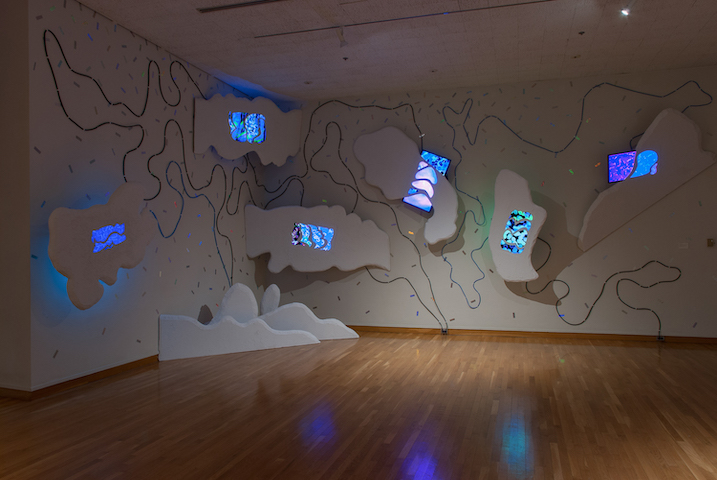
KT Duffy, And I Can’t Say That I’ll Miss My Human Form, foam, acrylic, plywood, tablets, USB cables, LED monitors,
media players, custom software, vinyl, 16′ x 23′ x 13′, 2018
In the installation, And I Can’t Say I’ll Miss My Human Form (2017-2018), this multifaceted expression of self is also evident. Can you walk us through the conceptual and applied creation of this work?
This site-specific installation explores speculative ideas on the evolution of the human form. As human animals we all live in these relatively similar looking meat suits which we use to physically move through the world. We have evolved to look and behave this way because of mutations/glitches in the code of our ancestors. For these glitches to be advantageous, and in turn to be passed onto the next generation, the conditions in the environment had to be just right to make it advantageous. So I like to think about how if those conditions weren’t perfect at that exact moment, how would the divergence of our evolutionary path have changed the entire trajectory of what a human experience is.
The scale and pop color palette is meant to draw the viewer into the piece with a sense of “OOOooOOOoo, SPARKLES!!” Once the viewer is engaged, they begin to consider how the forms in the installation are reminiscent of both their bodies and the natural landscape. Their breath and movements begin to line up with the timing of the animations and slowly oscillating lights. The animations provoke them to consider all the lumpy gushy things floating around inside of them while simultaneously evoking images of microorganisms underneath a microscope. In this installation space, these multilayered references become a collapsed metaphor for the way all living things and all elements within our galaxy are inextricably connected, and quite literally related. It is my hope that the installation inspires the viewer to consider a different modality of existence. One which is radically altered, but equally as profound, beautiful and grotesque as our own.
Who we are, or rather who we think we are, is not set. It’s fluid, changing, and mushing around all the time. Parts of you are dying and new parts are coming online everyday. Within my body is this whole pulsing system full of different kinds live squiggly things that are existing on a totally different scale and timeline that the “I” of “me” is. Our bodies are capable of incredible sci-fi level things, and by being here now the past and the potential future is literally living inside of you! You are atoms from across the universe compressed into this strange lump that by some swirling mystic coincidences ended up being born. But when you scale all this up to the “person,” it is here where the limitations are placed. It is our “peoplehood” or perhaps your determined level of personhood, that limits bodies(persons) to be relegated to specific segments of society. So, I want this installation to obliterate the limiting notions of personhood and to kind of explode that untapped human potential into a spacey-sparkle-party. I like to use the material of the video and screen as a stand in for these limitations. Monitors come in standard aspect ratios and sizes. These limitations present an opportunity to break out of the normative media ratio, leading to facets whose material transforms from constraint to bridge.
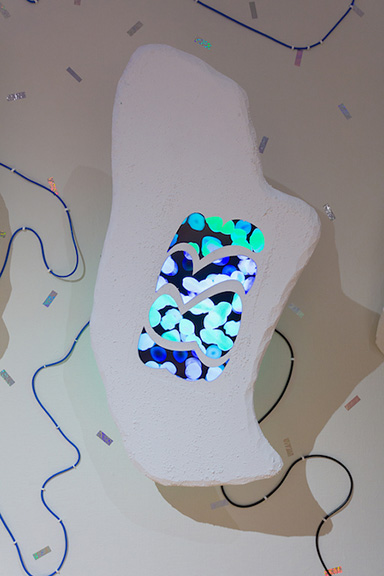
KT Duffy, And I Can’t Say That I’ll Miss My Human Form (Detail), foam, acrylic, plywood, tablets, USB cables, LED monitors, media players, custom software, vinyl, dimensions variable ~ 16′ x 23′ x 13′, 2018
You grew up here on the southwest side, I believe near Midway Airport, studied at Loras College in Dubuque, Iowa, then in Baltimore, at the Maryland Institute College of Art (MICA), then landed back in Chicago. Initially, you were trained formally in studio art practices. Then, you became immersed in new technology and your focus shifted. I’m wandering what piqued this shift?
I am indeed from the Midway area. Fight me! 🙂
In high school and undergrad what interested me most was hyperrealistic painting. In retrospect, I realized that my interest was in the technical skill, and not so much in the painting. I was also pretty sporty in that time of my life. I could juggle a soccer ball all day and loved the technical aspect of the game. I still have dreams about slicing a defense with that perfect through ball, but I really wasn’t interested in all the other stuff that came along with being in an athletic environment. Like why is everyone yelling? At Loras I double majored in Social Work and Digital Arts. I loved the content of the social work degree, but the practice of it was not for me.
What I’m getting at is that I’m a technician and a person who is really interested in applied research. So when I had a faculty member in undergrad introduce me to working with video in FINAL CUT PRO (do y’all remember, swoon.) I was just like THAT’S IT! WTF! Video was definitely my gateway drug. In grad school I got into animation, and from there I got into coding, and from there digital fabrication. I worked as a designer and developer for a while as my first job after undergrad where I made websites for nonprofits. I then worked at this app company during and after grad school. Through all these experiences, I totally fell in love with the medium of technology. I’m ok at best as a professional designer and developer, but it was more the material and the medium that interested me. The applications of this medium are seemingly endless, and there is always so much more to learn. Learning as I go is a huge part of my practice. It’s definitely a medium that will drive you mad, but also when you figure something out it’s seriously glorious. It’s addicting.
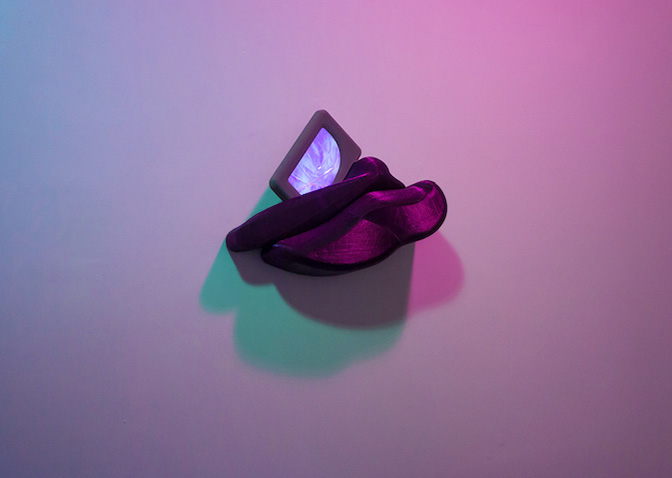
KT Duffy, Akin, PLA, tablet, looped video, cellophane, dimension variable, 18” x 20” x 7”, 2018
You are working in various new medias that rely on computer technology and 3-D printing. These works appear clearly imbedded in our present day. In addition, I see the content addressing the transformation of our humanity through the pervasiveness of new media. Can you share your thoughts on this crossroads we are currently at and how it relates to your investigations?
I honestly feel like I am not specifically smart enough to answer this question adequately. This is such a huge topic. I appreciate you asking this though because sometime I have daydreams of dropping everything I’m doing and pursuing another career where I research these implications and write very dense academic papers.
Despite my inadequacies, I am definitely interested in the merging of the device and the body in my work. In some ways it’s more subtle and in other ways it’s more obtuse and humorous. For example in Lo, it’s literally a lumpy humanoid form inspired by art historical poses of the “classical body” with a tablet shoved in the bum. ¯\_(ツ)_/¯
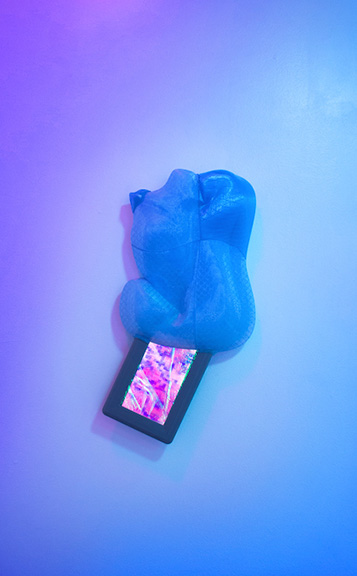
KT Duffy, Lo, PLA, tablet, looped video, cellophane, dimension variable, 18” x 20” x 7”, 2018
In terms of speculation though, perhaps one day in the not so distant future we will get to a point where there will be a really elegant fusing of our digital and physical lives and experiences. However, no matter how much tech we pour into our biological system, or how many metrics we have on our steps a day or whatever, we are still going to be these awkward mammals with huge brains and weird bodies.
On a more serious note, I think our humanity is in real need of a severe transformation, and was so prior to the latest trend of technological utopianism that is silicon valley. I think we have this notion that technology is going to save us. And in ways it has. However, I think the internet and social media in particular are great examples of the dichotomy that presents itself with the introduction of a new, revolutionary technology. For instance, the internet is an amazing place where folx can form communities, create new worlds, and embody complex identities as our online selves. And at the same time, the internet is a terrifying place where folks can form communities, create new worlds, and embody complex identities as our online selves.
It seems like its a good fit for new media artists to talk about all the nefarious things that technology can and will do to our humanity. And don’t get me wrong, I love a dystopian sci-fi novel more than anything (y’all I just finished NK Jeminsin’s Broken Earth Trilogy. holy, lord), and I think the folx that have dedicated their lives bringing awareness to the ways technology further disenfranchises people are incredible, check out Amnesty International Troll Patrol Findings: https://decoders.amnesty.org/projects/troll-patrol/findings
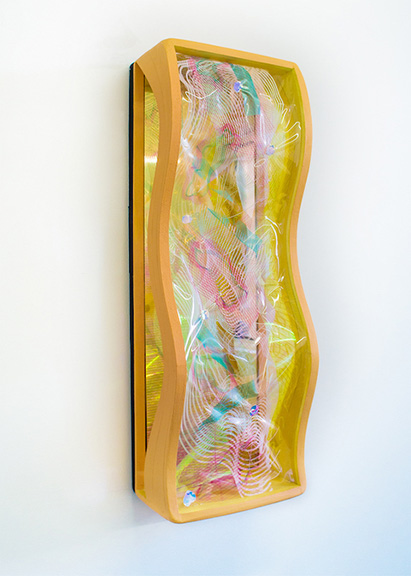
KT Duffy, Topol, etched mirrored acrylic, generative plotter drawings on vellum, MDF, 35” x 12” x 8”, 2018
However, in my creative practice I am more interested in a playful, kinda stupid articulation of this investigation. I like the idea of working with robots, technology and pieces of software that are just as inept at understanding the world as I am. I am really interested in the “glitch” as a marker of my hand, and perhaps the agency of the device itself.
One last thing I will discuss in the vein of this question is User Experience and User Interface (UX/UI). I inevitable end up teaching some of this theory and design fundamentals in my web code and interactive classes. I find the speculative design concepts around UX/UI to be really interesting to bring to my students. To quickly sum them up, the best User Interface would be to have no interface at all. The best User Experience will be one that does away with the device, and perhaps appears in your visual range (check out NNedi Okorafor’s Binti: The Night Masquerade, for a STUNNING visual description of what this magic could look like). So it’s exciting to let the students run with this future-oriented, open-ended format. But in the nowtimes, when I am teaching this stuff, a lot of the language that is used is stuff like “a frictionless experience” and “seamless integration”. When the reality is that as a human, your experience of the world couldn’t be any farther from frictionless and seamless. As we begin to interact more and more with the device, and as a result more and more with UX and UI, we find ourselves not thinking and never having to make our own decisions because the design does that for you. We find ourselves silouded into groups of folx that we agree with because disagreeing with folks falls outside of a good user experience. However, we need to disagree! And we need that friction! So in class I am always encouraging students to consider this in their designs, and to ask questions like “How can we create products that don’t contribute to the downfall of our civilization” and “how can we use the mind judo of UX and UI to actually solve problems that exists”, and not just invent for invention sake. When I deliver these more speculative topics to students I often file them under the category of “art” rather than design, because the possibilities in the space of “art”, at least for my students and I, tend to lend to more expansive approach and possibilities.
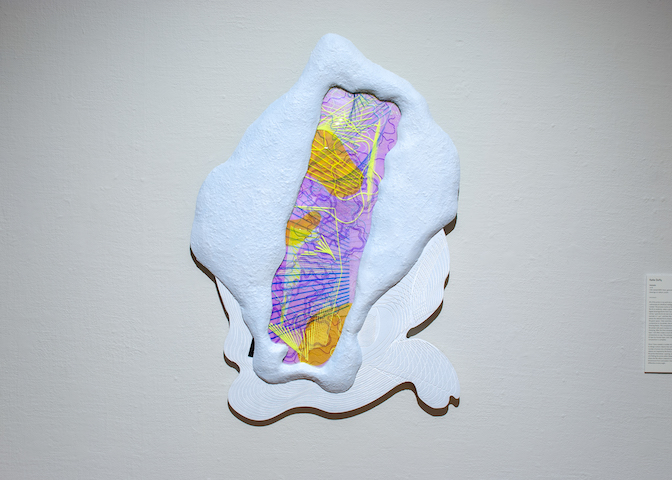
KT Duffy, Anemoia, CNC etched MDF, foam, generative plotter drawings on vellum, acrylic, 47” x 38” x 2.5”, 2018
What do you value most in your aesthetic practice?
Hm. The outlet to make connections to and from things that are seemingly disparate. The ability to endlessly explore things and get into the weeds of the super technical details. Being able to nerd out on stuff like that, and to call up any discipline I want as a creative medium.
I also do a lot of collaborative work and organizing. I really value that creative exchange/ facilitation of other folx doing their thing. I also really value the opportunity to learn from and share, in this vulnerable creative way, with someone from different experiences than my own.
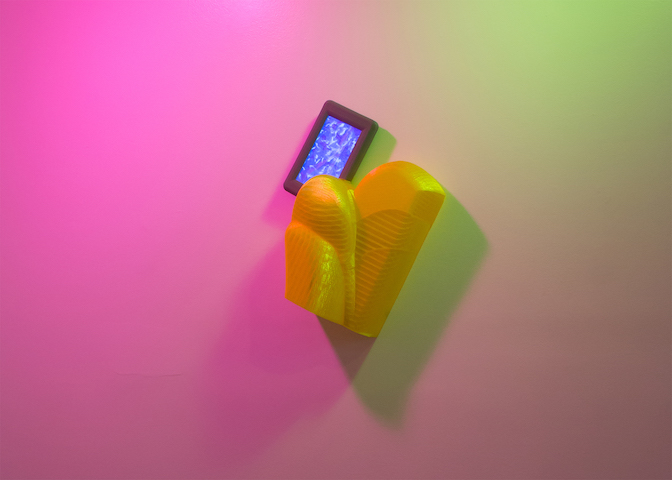
KT Duffy, Akjai, PLA, tablet, looped video, cellophane, dimension variable, 18” x 20” x 7”, 2018
In addition to your aesthetic investigations you teach. You are Assistant Professor of Art & Technology at Northeastern Illinois University. Are there any specific items you regularly share with your students? Do you see any overlap in this effort with your Investigations?
There is definitely an overlap. When I was a younger faculty person at MICA I learned that it’s best to lean into what you are passionate about, and then bring that to the students and see where they can take it. I’m really passionate about the medium of coding and technology. There are so many implementations of this medium, and I never want to limit myself to where I can take them. So I try to instill that in my students. I want it to be clear that there is no one right way of using creative technology, and that one should not let their lack of skill hold them back from accessing these tools. As an artist, I get really excited when the IRL and the URL get to come together, so a lot of my course projects and instruction focus on having the students figure out how to make that leap.
In my classroom we make to learn, which is also what I do in my practice. I am always picking up new skills, using things wrong, experimenting, and combining things that shouldn’t go together. I don’t want my students to be held back by theory, or validation or the “proper work flow” of anything. Breaking things and interacting with them in a tactile way is the best way to jump in and get started.
Overall, I want to give my students hard skills, but leave the rest open ended enough so they can figure out what all this stuff means to them and how best to utilize it in service of developing their own creative voice. The students I get to work with, I would say the majority of them are folx who are underrepresented in tech fields. One of my missions in life is to demystify coding and technology for creatives, with a focus on those underrepresented in STEAM fields. I know first hand how overwhelming it can be to start out on this type of path, especially if you don’t see anyone that looks like you, or identifies like you. I also know how powerful and affirming it feels to write your first interactive program, or to hold something you designed and 3d printed in your hands for the first time. These mediums are not just creative tools for making client based stuff, but they are also wildly appropriate tools for identity construction, questioning power and ownership, and constructing narratives that fall outside of what society deems as normative.
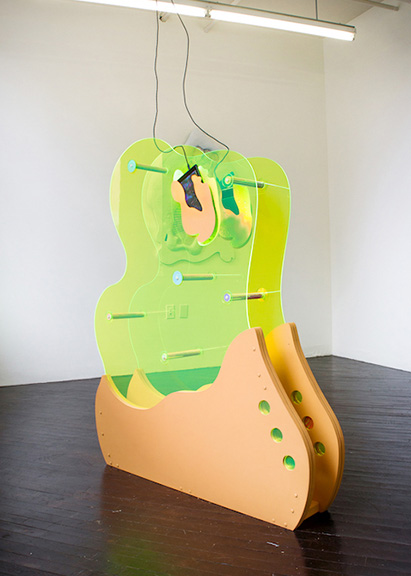
KT Duffy, Germline, CNC routed acrylic, plywood, fiberglass tubing, tablet, USB, 40” x 48” x 12”, 2018
2019 is here. You appeared to have had a quality 2018. You did solo exhibits, The Eventualities Come at Terrault Contemporary in Baltimore, and Agentive Valley at the South Bend Museum of Art in Indiana. So, what’s the plan for the remainder 2019 and beyond? What are you currently working upon? Do you have any specific goals for the new Year?
My 2019 goal is to stay focused on what really matters to me. I’m a person that is interested in a lot of different things, and I tend to say YES to a lot of stuff without fully thinking about whether or not its sustainable, or adding to/in line with my goals. It’s hard because I legit want to do all of the things, but that isn’t practical, and causes me to get burnt out by the things I love doing. I’m trying this thing in 2019 where I’m not working all the time. That busy aesthetic is gross. I wanna enjoy the folx in my life and not have so much anxiety over constantly producing. I just gotta find the right balance I guess, which I will be tweaking the rest of my life 🙂
In terms of shows, my collaborator Ali Seradge (whom I am affiliated with in a variety of personal and creative endeavours) and I just put up an installation at Comfort Station. Our collab entity is called PIXELFACE. The installation is part of Comfort Station’s Winter Takeover, where the work can only be viewed outside of the gallery, essentially turning the Comfort Station building into a site specific public work. It’s something I have always wanted to do, fill every window of a building with different video materials, so a huge thanks to Comfort Station for making this boi/grl’s dreams come true. We are having a little reception for this on the 19th down the street at Rocking Horse on Milwaukee at 5:30 on Jan 19th! There we will eat tater tots and have beverages, before we take a walk over to the piece for a viewing. There will be hot cocoa! I’m also currently in a faculty biennial show at my school.
On the roster for this upcoming year, I am in a group show at the Greater Denton Arts Council, “Hard and Soft,” opening Feb 1st, and I will be in a two person show at Mono 8 Gallery in Manilla in April. This will be my first international opportunity and I’m really excited.
In May I have a residency at Latitude in Chicago. This is going to be a challenge for me, as the medium and resources they provide are just a bit outside my everyday practice, so I’m really interested to see what can come of this.
I do a lot of coding and tech workshops, so I have two of those coming up at University of North Texas, Rutgers-Camden, and Williams College.
In terms of academic stuff, I’ll be working on getting our new MakeSpace going at NEIU, and I recently started an artist residency hosted out of the MakeSpace. I’m excited to keep bringing artists in to work with our students and to provide the artists with digital fabrication tools in the MakeSpace. I am also working on getting some MakerSpace fellowships going for students in the lab. We have a really amazing creative community that has already formed around the half finished MakeSpace. So I’m really excited to give students opportunities to that will help continue this community to grow.
In 2019 I will be publishing a couple artist books. One will be a recap of a panel called “WTF is new media?” that I organized in conjunction with my solo show at Terrault Contemporary in Baltimore this past September. I will also be working with Sibyl Press to Publish a quasi manifestx type thing, that will also have a large research component to it called “Coding as feminist practice/Feminism as techno-collaborative problem solving.”
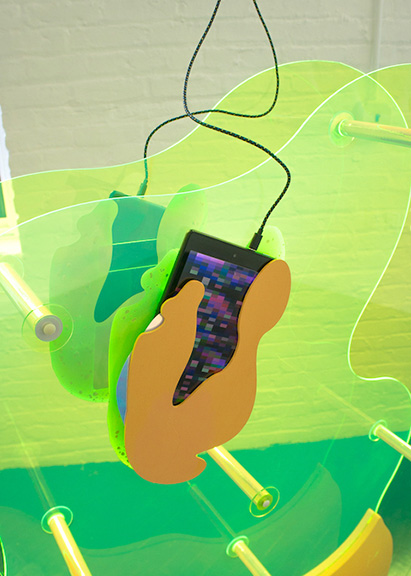
KT Duffy, Germline (Detail), CNC routed acrylic, plywood, fiberglass tubing, tablet, USB, 40” x 48” x 12”, 2018
For additional information on the aesthetic practice of KT Duffy, please visit:
Comfort Station – https://comfortstationlogansquare.org/
KT Duffy – http://ktduffy.com/
New Media Caucus – http://www.newmediacaucus.org/member-spotlight-kt-duffy/
Slice of Life – https://inertiastudiovisits.com/2017/06/05/a-day-in-the-life-of-chicago-artist-and-professor-katie-duffy/
The Visualist – http://www.thevisualist.org/tag/kt-duffy/
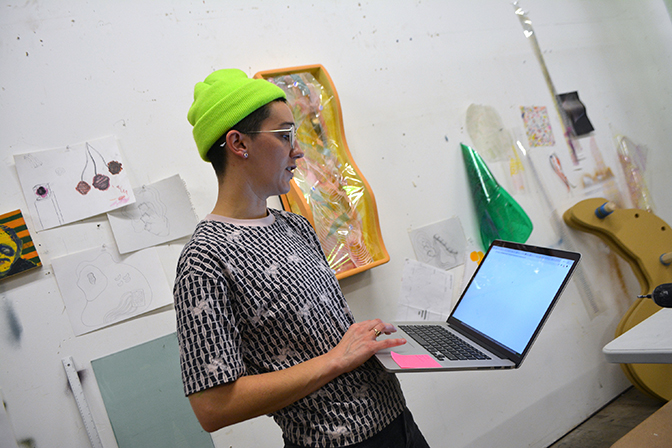
KT Duffy, new media artist, Chicago, 2018
Artist interview and portrait by Chester Alamo-Costello


